IBM 129 Card Data Recorder
This weekend PMF and I cleaned an IBM 129 Card Data Recorder and were able to fairly reliably punch cards once we were done. When we started it would frequently jam during feeding, mis-feed during the punch, and not cleanly stack the cards in the output bin.
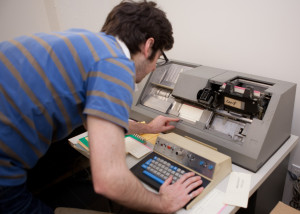
Most of the problem was thirty years of dust, card fiber and grime built up in the mechanisms. The output hopper was full of it and needed a good cleaning to reliably pick up cards into the output stack:
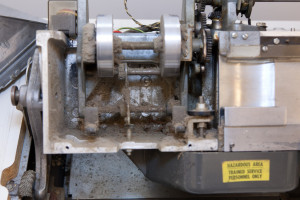
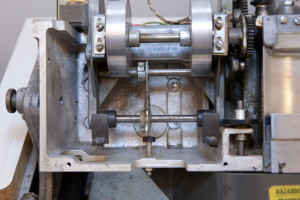
The card punch and keyboard only appear to be seated on the table. They are just the tip of the iceberg — much of the power and computerized bits fill the space underneath the desk. The bottom of the keyboard is in a cut-out in the desk surface and has a traditional typewriter mechanism that closes reed switches when each key is pressed, except for the special keys like “FEED”, “REL” and “REG” that directly actuate lever switches.
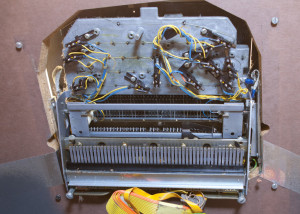
Luckily the “monolithic memory” was still fully functional. Debugging the logic part of the system would be an immense task — it is implemented with a wire-wrapped backplane and fills the bottom portion of the desk. Hidden behind it was a bookshelf with full schematics and a “Maintenance Theory” manual that described the interaction of the various components.
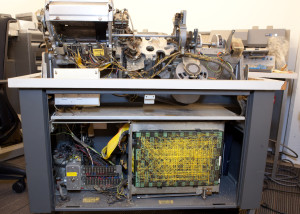
The individual boards in the backplane appear to be hand soldered and mostly consist of the what appears to be the same component, likely Solid Logic Technology blocks:
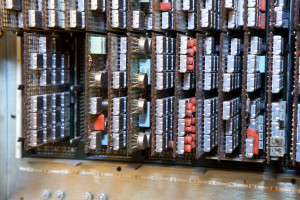
Once it was cleaned up, PMF tried puching some cards with great success:
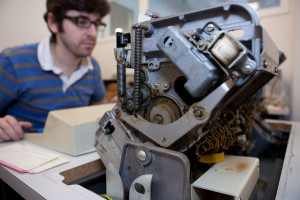
We were able to verify that the registration of the cards and the punch were fairly accurate with this card guage:
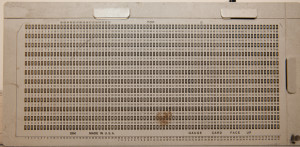
The ink tape of the print head that marks a human readable version of the EBCDICHollerith Code was totally dry. Perhaps we can adapt a typewriter ribbon to work:
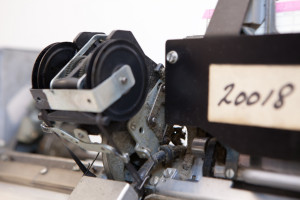
Also hidden in the bottom of the card punch was an incident report log, with the last entry from 1980. For a device manufactured starting in 1973 that is a very long life. The logbook is sitting on an IBM card sorter, which will be cleaned up later.
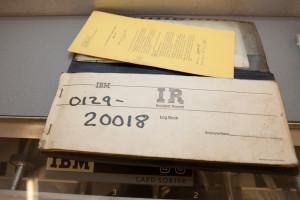
We ended up not using the IBM-6 Oil Spray:
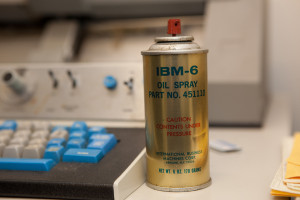
Here’s a 1971 advertisement for the IBM 129 that notes its new features, including the monolithic memory, the ability to tabulate columns of the cards, and the automated card feeding, punching and stacking mechanisms:
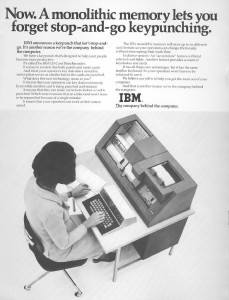
And here are more photos and video of the card punch. Once we have the manuals scanned and cleaned up, I’ll post links, too.
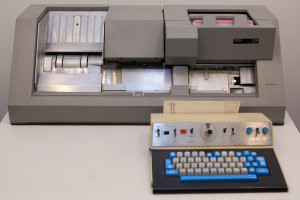
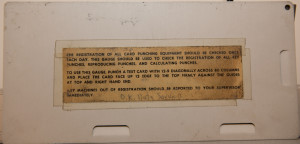
I started college Fall 1979. University of Maryland, College Park, required I use these for writing my programs. I never dropped a deck and the operators who fed the cards into the UNIVAC did not either. I was lucky.
Juniors and senors were allowed to use the DEC writers. 132 wide 300 baud printing terminals. We were given some minuscule amount of storage or keep our programs on disk. This does mean we only had a line editor.
All jobs were batch jobs. No instand gratification.
Glad those days are gone.
Will NYCR send a contingent to this year’s Vintage Computer Festival East (http://www.vintage.org/2012/east/) ? It’s May 5-6 at our museum on the NJ shore. We’ve got our exhibit hall, tours, etc., and a great speaker lineup — this year it includes Tom Kurtz (inventor of BASIC) and Dan Kottke (Steve Jobs’ college buddy / India travel companion / early Apple engineer). Another idea: we’d love to have Bre on a panel discussion about 1970s homebrew computing v. modern homebrew robotics. – Evan K. of MARCH / VCF.
The IBM card punched use Hollerith code. Check it out. EBCDIC was an in-memory representation that preceded ASCII.
Thanks for the correction! I’ve updated the article.
The IBM card punched use Hollerith code. Check it out. EBCDIC was an in-memory representation that preceded ASCII.
Very good statement, +100500
http://www.plagiarismdetect.com
Extended Binary Coded Decimal Interchange Code
Wow that brought back some memories. I took EDP I-II in 1978-1980 and I cannot tell you how many COBOL programs I typed on the very machine :-O
Are you interested in selling IBM 129. We are a reseller and have an application for this dinosaur. I actually operated one of these when i was a teenager
Dave 858 722-5500 [email protected]
Check bitsavers.org first before you scan any manuals. On the other hand, if you have something not on their site, Al Kossow would be happy to take it.
I used a punch machine like this in my first few years of college. IBM, but not sure of the model number.
Wonderful. No really! I remember using some older machines in the 1970’s (029 and 026 ?), my first introcuction to computers (ahh, if you find a Litton Monrobot…) And as late as the 1980’s we still had to submit punch card jobs at Portland State University CS department. Thanks for bringing back fond memories: I’m fond of not having to use this, but if I could find it I should turn the old card deck into an art project.
In the student keypunch room at Purdue University (circa 1966?) I learned how to clear jams in keypunches when there would be lines for the machines, but one would be unused because it was jammed. If I could clear the jam, I was then first in line (already seated, actually). The main procedure was to cycle power (to reset relays, etc) then exercise each row until it jammed again or the bits of cardboard were chewed up so they could be pushed out of the way.
I am interested in purchasing your 129 unit – [email protected]
That brings back memories. I actually had a hand in designing the machine. Fixing the logic part of the machine would be tricky. The standard technique at the time was to “Easter egg” the cards until it worked.
I remember Roger Pett, Electrical Engineer from IBM Canada who worked with me at the IBM Poughkeepsie Lab in NY. At the end of our 129 project he was sent to IBM Scotland to support the manufacture of the 129 and I was sent to Canada to replace him during that two-month summer period in 1971. I was the lead Electrical Engineer responsible for all the electrical and logic design of the 129 machine. I was involved with all IBM keypunch design activity from 1994 thru 1991. I am now 85 years old with lots of good memories of that period of time at IBM